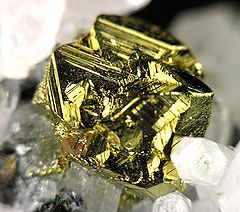Chalcopyrite
| Chalcopyrite | |
|---|---|

Twinned chalcopyrite crystal from the Camp Bird Mine, Ouray County, Colorado. Crystal is about 1 cm × 1 cm.
|
|
| General | |
| Category | Sulfide mineral |
|
Formula (repeating unit) |
CuFeS2 |
| Strunz classification | 2.CB.10a |
| Crystal system | Tetragonal |
| Crystal class | Scalenohedral (42m) H-M symbol: (4 2m) |
| Space group | I42d |
| Unit cell | a = 5.289 Å, c = 10.423 Å; Z = 4 |
| Identification | |
| Formula mass | 183.54 g/mol |
| Color | Brass yellow, may have iridescent purplish tarnish. |
| Crystal habit | Predominantly the disphenoid and resembles a tetrahedron, commonly massive, and sometimes botryoidal. |
| Twinning | Penetration twins |
| Cleavage | Indistinct on {011} |
| Fracture | Irregular to uneven |
| Tenacity | Brittle |
| Mohs scale hardness | 3.5 |
| Luster | Metallic |
| Streak | Greenish black |
| Diaphaneity | Opaque |
| Specific gravity | 4.1 – 4.3 |
| Optical properties | Opaque |
| Solubility | Soluble in HNO3 |
| Other characteristics | magnetic on heating |
| References | |
Chalcopyrite (pronunciation: /ˌkælkəˈpaɪraɪt, -koʊ-/KAL-ko-PY-ryt) is a copper iron sulfide mineral that crystallizes in the tetragonal system. It has the chemical formula CuFeS2. It has a brassy to golden yellow color and a hardness of 3.5 to 4 on the Mohs scale. Its streak is diagnostic as green tinged black.
On exposure to air, chalcopyrite oxidises to a variety of oxides, hydroxides and sulfates. Associated copper minerals include the sulfides bornite (Cu5FeS4), chalcocite (Cu2S), covellite (CuS), digenite (Cu9S5); carbonates such as malachite and azurite, and rarely oxides such as cuprite (Cu2O). Chalcopyrite is rarely found in association with native copper.
...
Wikipedia
